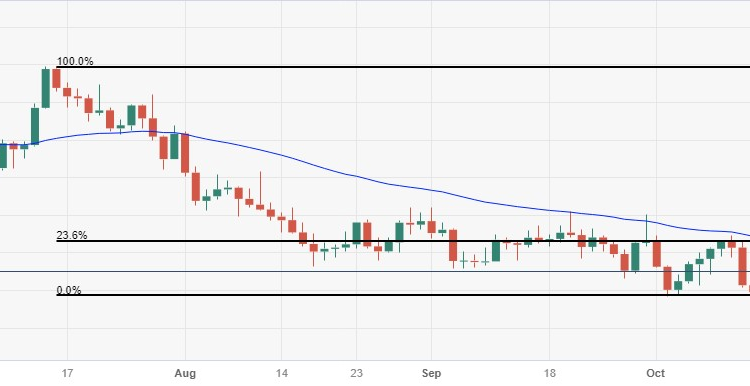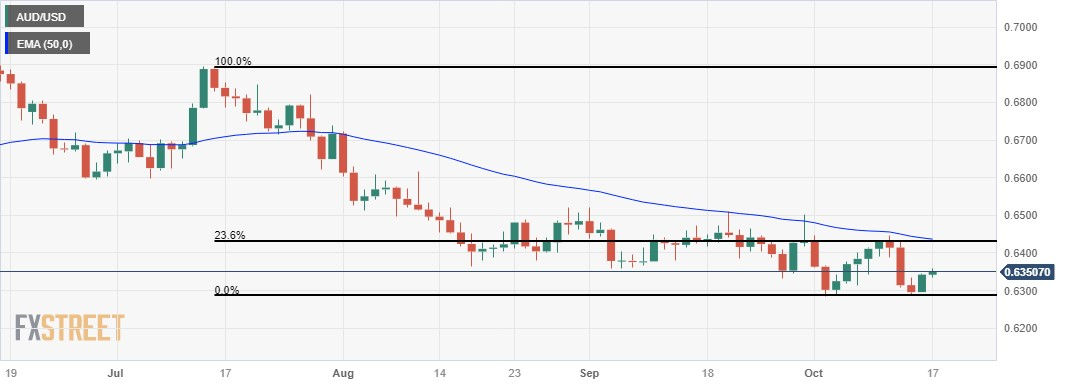Australian Dollar extends gains on second day after RBA minutes, US Retail Sales eyed
- Australian Dollar continues to gain post-release of the RBA Meeting Minutes.
- RBA board members favored to maintain the current interest rates.
- US Dollar faces challenges due to the dovish comments made by multiple Fed members.
The Australian Dollar (AUD) extends its gains on the second successive day, remaining firmer against the US Dollar on Tuesday. The pair receives upward support after the hawkish Reserve Bank of Australia (RBA) minutes for the October 2023 meeting were released on Tuesday.
Australia’s central bank board was involved in the consideration of whether to raise interest rates by 25 basis points (bps) or to maintain the current rate. However, the board members concluded that the stronger case was to keep the rates steady. They made this judgment based on factors such as inflation data, employment figures, and updated forecasts, which would be available at the November meeting.
RBA’s board members acknowledged that there were significant concerns about upside risks to inflation. This suggests that the board is cautious about potential factors that could lead to an increase in inflation
Australian Weekly ANZ Roy Morgan Consumer Confidence survey, released on Tuesday, indicates a decline in the nation's Consumer Confidence. The reading fell to 76.4 compared to the previous figure of 80.1. The decline is observed across all sub-indices, reflecting a more cautious or negative sentiment among consumers.
The US Dollar Index (DXY) faces downward pressure, and this is attributed to the dovish comments made by multiple Federal Reserve officials indicating that no further interest rate hikes are anticipated for the remainder of 2023. The dovish stance suggests a cautious approach by the central bank, emphasizing a reluctance to tighten monetary policy in the current economic environment.
Federal Reserve Bank of Philadelphia President Patrick Harker added to this sentiment by stating on Monday that the central bank should avoid creating new pressures in the economy by increasing the cost of borrowing. Harker further expressed the view that in the absence of a significant shift in the data, the Fed should maintain interest rates at their current levels.
Daily Digest Market Movers: Australian Dollar continues to gain on hawkish RBA minutes
- RBA could introduce a central bank digital currency (CBDC). Brad Jones, Assistant Governor (Financial System) at the RBA, discussed the tokenization of assets and money in the digital era at The Australian Financial Review Cryptocurrency Summit.
- Australian Consumer Inflation Expectations for October were reported at 4.8% on Thursday, reflecting a slight increase from the September figure of 4.6%. The rebound in inflation observed in August, primarily influenced by elevated oil prices, raises the likelihood of another interest rate hike by the RBA.
- The National Bureau of Statistics of China reported on Friday that Chinese inflation experienced a decrease in September. This development could exert pressure on the Australian Dollar (AUD). The Chinese data indicates ongoing economic challenges despite the recent government stimulus plan aimed at supporting the nation in achieving its 5% growth target.
- The ongoing conflict in the Middle East introduces an additional layer of complexity to the situation. This geopolitical factor could potentially prompt the RBA to implement a 25 basis points (bps) interest rate hike, reaching 4.35% by the end of the year.
- Investors appear to be exercising caution in making aggressive bets on the US Dollar (USD), given the uncertainty surrounding the Fed policy rate trajectory. The lack of a clear direction from the Fed on interest rates is influencing market sentiment and contributing to hesitancy among investors.
- The recovery in US Treasury yields from recent losses is seen as a potential factor that could provide support to the US Dollar. The 10-year US Treasury bond yield stands at 4.72%, by the press time.
- Additionally, the USD continues to benefit from safe-haven flows amid rising geopolitical tensions between Israel and Palestine. Safe-haven currencies, including the US Dollar, tend to attract demand during periods of heightened uncertainty and geopolitical risks.
- According to an undisclosed source to Reuters, US officials and Israel have engaged in discussions about the possibility of a visit by US President Joe Biden to Israel. The invitation for the visit reportedly came from Israeli Prime Minister Benjamin Netanyahu.
- Market participants will likely monitor the US Retail Sales and the Fed Beige Book report will also be eyed on Tuesday. The Australian employment data will be released on Thursday. Traders will take cues from these figures and find the trading opportunities around the AUD/USD pair.
Technical Analysis: Australian Dollar hovers around the psychological level at 0.6350 level
The Australian Dollar trades higher around the major level of 0.6350 during the Asian session on Tuesday. The 0.6300 emerges as the significant support level, which aligns with the monthly low at 0.6285. On the upside, a crucial resistance is observed at the major level of 0.6400. This level coincides with the 23.6% Fibonacci retracement level at 0.6429 and is lined up with the 50-day Exponential Moving Average (EMA) around the 0.6436 level. These technical indicators provide traders with insights into potential resistance zones that could influence the direction of the Australian Dollar.
AUD/USD: Daily Chart
Australian Dollar price today
The table below shows the percentage change of Australian Dollar (AUD) against listed major currencies today. Australian Dollar was the strongest against the Pound Sterling.
| USD | EUR | GBP | CAD | AUD | JPY | NZD | CHF | |
| USD | 0.02% | 0.09% | 0.07% | -0.15% | -0.03% | -0.03% | 0.04% | |
| EUR | -0.03% | 0.07% | 0.05% | -0.18% | -0.05% | -0.05% | 0.02% | |
| GBP | -0.10% | -0.08% | -0.02% | -0.25% | -0.12% | -0.12% | -0.06% | |
| CAD | -0.07% | -0.05% | 0.01% | -0.23% | -0.10% | -0.10% | -0.04% | |
| AUD | 0.15% | 0.17% | 0.24% | 0.23% | 0.11% | 0.13% | 0.19% | |
| JPY | 0.03% | 0.04% | 0.13% | 0.12% | -0.13% | -0.02% | 0.07% | |
| NZD | 0.03% | 0.05% | 0.13% | 0.09% | -0.12% | 0.01% | 0.07% | |
| CHF | -0.04% | -0.01% | 0.06% | 0.03% | -0.19% | -0.07% | -0.06% |
The heat map shows percentage changes of major currencies against each other. The base currency is picked from the left column, while the quote currency is picked from the top row. For example, if you pick the Euro from the left column and move along the horizontal line to the Japanese Yen, the percentage change displayed in the box will represent EUR (base)/JPY (quote).
Australian Dollar FAQs
One of the most significant factors for the Australian Dollar (AUD) is the level of interest rates set by the Reserve Bank of Australia (RBA). Because Australia is a resource-rich country another key driver is the price of its biggest export, Iron Ore. The health of the Chinese economy, its largest trading partner, is a factor, as well as inflation in Australia, its growth rate and Trade Balance. Market sentiment – whether investors are taking on more risky assets (risk-on) or seeking safe-havens (risk-off) – is also a factor, with risk-on positive for AUD.
The Reserve Bank of Australia (RBA) influences the Australian Dollar (AUD) by setting the level of interest rates that Australian banks can lend to each other. This influences the level of interest rates in the economy as a whole. The main goal of the RBA is to maintain a stable inflation rate of 2-3% by adjusting interest rates up or down. Relatively high interest rates compared to other major central banks support the AUD, and the opposite for relatively low. The RBA can also use quantitative easing and tightening to influence credit conditions, with the former AUD-negative and the latter AUD-positive.
China is Australia’s largest trading partner so the health of the Chinese economy is a major influence on the value of the Australian Dollar (AUD). When the Chinese economy is doing well it purchases more raw materials, goods and services from Australia, lifting demand for the AUD, and pushing up its value. The opposite is the case when the Chinese economy is not growing as fast as expected. Positive or negative surprises in Chinese growth data, therefore, often have a direct impact on the Australian Dollar and its pairs.
Iron Ore is Australia’s largest export, accounting for $118 billion a year according to data from 2021, with China as its primary destination. The price of Iron Ore, therefore, can be a driver of the Australian Dollar. Generally, if the price of Iron Ore rises, AUD also goes up, as aggregate demand for the currency increases. The opposite is the case if the price of Iron Ore falls. Higher Iron Ore prices also tend to result in a greater likelihood of a positive Trade Balance for Australia, which is also positive of the AUD.
The Trade Balance, which is the difference between what a country earns from its exports versus what it pays for its imports, is another factor that can influence the value of the Australian Dollar. If Australia produces highly sought after exports, then its currency will gain in value purely from the surplus demand created from foreign buyers seeking to purchase its exports versus what it spends to purchase imports. Therefore, a positive net Trade Balance strengthens the AUD, with the opposite effect if the Trade Balance is negative.



Comments are closed.